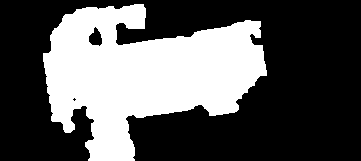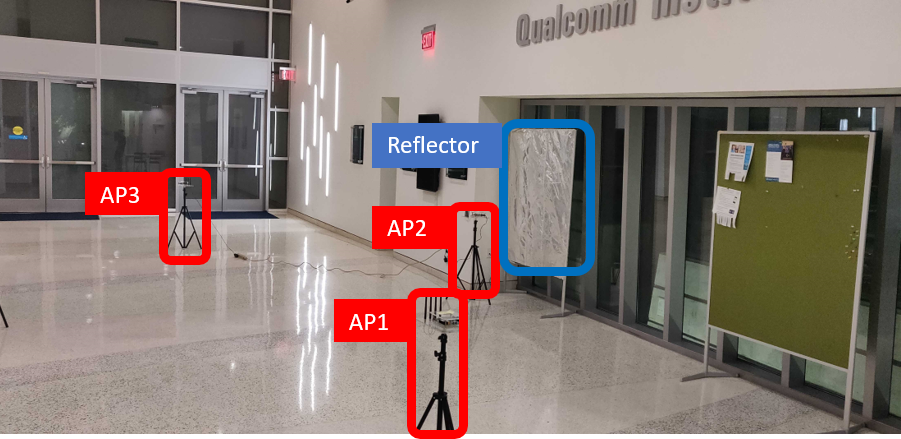Wireless Indoor Localization Dataset (WILD)
Authors: Roshan Ayyalasomayajula, Aditya Arun, Chenfeng Wu, Dinesh Bharadia
Updates
December, 2022
2nd version of WILD dataset has been released through a Kaggle Competition.
June 20, 2020
First release of the Location labelled WiFi CSI data and features data used in DLoc.
Jan, 2020
DLoc has been accepted in Mobicom 2020.
Documentation
Two Different Environments
1. Complex High-multipath and NLOS environment (1500 sq. ft.) with 5 different setups in Jacobs Hall UCSD
jacobs_Jul28: 18m X 8m setup with 4 APs in Jacobs hall ground floor for data collected on July 28, 2019.
jacobs_Jul28_2: 18m X 8m setup with 4 APs in Jacobs hall ground floor for data collected on July 28, 2019, one hour after jacobs_Jul28.
jacobs_Aug16_1: 18m X 8m setup with 4 APs in Jacobs hall ground floor for data collected on August 16, 2019 with extra furniture placed randomly.
jacobs_Aug16_3: 18m X 8m setup with 4 APs in Jacobs hall ground floor for data collected on August 16, 2019 with extra furniture placed randomly.
jacobs_Aug16_4_ref: 18m X 8m setup with 4 APs in Jacobs hall ground floor for data collected on August 16, 2019 with extra furniture placed randomly with an added reflector. (a huge aluminium plated board)
2. Simple LOS based environment (500 sq. ft.) with 3 different setups in Atkison Hall UCSD
July16: 8m X 5m setup with 3 APs in Atkinson hall ground floor for data collected on July 16, 2019.
July18: 8m X 5m setup with 3 APs in Atkinson hall ground floor for data collected on July 18, 2019.
July22_2_ref: 8m X 5m setup with 3 APs and 2 additonal reflectors (a huge aluminium plated board) placed in Atkinson hall ground floor for data collected on July 22, 2019.
We provide both the CSI data for all the above setups and the post-prcessed features for running our DLoc network. All the corresponding links can be found below.
Channels
The CSI data is named as channels_<dataset_name>.mat. These MATLAB files are stored using HDF5 file structure and contain the following variables:
- channels: [ n_datapoints x n_frequency x n_ant X n_ap ] 4D complex channel matrix.
- RSSI: [ n_datapoints x n_ap ] 2D recieved signal strenght matrix.
- labels: [ n_datapoints x 2 ] 2D XY labels.
- opt: various options specific for the data generated
- opt.freq : [n_frequencyx1] 1D vector that describes the frequency of the subcarriers
- opt.lambda: [n_frequencyx1] 1D vector that describes the wavelength of the subcarriers
- opt.ant_sep: antenna separation used on all of our APs
- ap: n_ap cell matrix. Each element corresposning to [ n_ant x 2 ] XY locations of the n_ant on each AP.
- ap_aoa: [ n_ap x 1] vectors that contains the rotation that needs to be added to the AoA measured at each AP (assumes that the AoA is measured about the normal to the AP’s antenna array)
- d1: The sampled x-axis of the space under consideration
- d2: The sampled y-axis of the space under consideration
Features
The 2D heatmap features data used in DLoc is named as features_<dataset_name>.mat. These MATLAB files are stored using HDF5 file structure and contain the following variables:
- features_with_offset: [ n_datapoints x n_ap x n_d1_points X n_d2_points ] 4D feature matrix for n_ap with offsets in time
- features_without_offset: [ n_datapoints x n_ap x n_d1_points X n_d2_points ] 4D feature matrix for n_ap without offsets in time
- labels_gaussian_2d: [ n_datapoints x n_d1_points X n_d2_points ] 3D labels matrix that contisn the target images for the location network.
- labels: [ n_datapoints x 2 ] 2D XY labels.
Downloads
Channel Downloads:
Individual Downloads:
Feature Downloads:
Individual Downloads:
Data Split:
Dataset Split IDs to replicate results from DLoc using the open-sourced code can be downloaded at split_ids.
Folder Metadata: data_split_idx
- data_split_ids_<dataset_name>.mat
- fov_test_idx: MATLAB indices of the points that are selected in dataset_<dataset_name>.mat to generate dataset_fov_test_<dataset_name>.mat
- fov_train_idx: MATLAB indices of the points that are selected in dataset_<dataset_name>.mat to generate dataset_fov_train_<dataset_name>.mat
- non_fov_test_idx: MATLAB indices of the points that are selected in dataset_<dataset_name>.mat to generate dataset_non_fov_test_<dataset_name>.mat
- non_fov_train_idx: MATLAB indices of the points that are selected in dataset_<dataset_name>.mat to generate dataset_non_fov_train_<dataset_name>.mat
- data_split_ids_<dataset_name>_space_gen.mat
- test_idx: MATLAB indices of the points that are selected in dataset_<dataset_name>.mat to generate dataset_test_<dataset_name>.mat.
- train_idx: MATLAB indices of the points that are selected in dataset_<dataset_name>.mat to generate dataset_test_<dataset_name>.mat.
MapFind Ground Truth Values:
MapFind robot collected the ground truth data and these ground truth measurements can be downloaded at Robot Ground Truth Measurements.
Folder Metadata: timestamps
- timestamps_edit_<dataset_name>.mat
- aoa_gnd: [ n_datapoints x n_ap ] 2D matrix. Ground Truth Angle of Arrivals for each AP. The column idx refers to the correspond AP idx.
- tof_gnd: [ n_datapoints x n_ap ] 2D matrix. Ground Truth Time of Flight for each AP. The column idx refers to the correspond AP idx.
- labels: [ n_datapoints x 2 ] 2D XY labels.
- timestamps: [ n_datapoints x 2 ] 2D matrix. Time in secs for each datapoint measured, with the first datapoint at time t=0sec.
- orientations_quat: [ n_datapoints x 4 ] 2D matrix. Ground Truth heading of the robot for each datapoint measured in Quartenions.
- orientations_rpy_deg: [ n_datapoints x 3 ] 2D matrix. Ground Truth heading of the robot measured as Raw-Pitch-Yaw (index 1-2-3 respectively) in degrees.
- orientations_rpy_rad: [ n_datapoints x 3 ] 2D matrix. Ground Truth heading of the robot measured as Raw-Pitch-Yaw (index 1-2-3 respectively) in radians.
All the dataset downloads are PASSWORD protected. To get the password, please read and agree to the terms and conditions. You can then proceed to download datasets from the links above.
CITATION
-
Ayyalasomayajula R, Arun A, Wu C, Sharma S, Sethi AR, Vasisht D, Bharadia D. Deep learning based wireless localization for indoor navigation. InProceedings of the 26th Annual International Conference on Mobile Computing and Networking 2020 Apr 16 (pp. 1-14).







